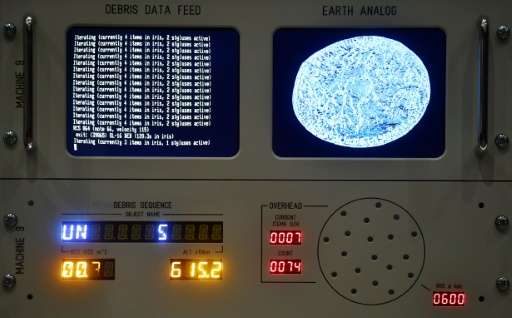UK 'space junk' project highlights threat to missions

The mass of "space junk" orbiting the Earth poses a serious threat to future exploration, a British scientist said on Friday at the launch of a project to raise awareness of the issue.
"Tackling the problem of space debris is one of humankind's greatest environmental challenges, but is also perhaps the one that is the least known," said Hugh Lewis, head of astronautics research at the University of Southampton.
He was supporting the launch of a creative project at London's Royal Astronomical Society by artists and scientists aiming to shed light on the 27,000 pieces of debris being tracked as they orbit the Earth.
There are believed to be around 100 million pieces in total, but some are too small to chart.
So-called "space junk" has been left in space during the many missions that have taken place since the Soviet Union launched Sputnik 1, the first artificial satellite, in 1957.
The debris now poses a serious threat to future space exploration, scientists warn.
"Every day, we use and rely on services provided by satellites without ever realising how vulnerable they are," said Lewis.
Space debris puts these satellites at risk of being destroyed or damaged and "may affect the dreams and ambitions of future generations to work and live in space", he said.
The project, titled "Adrift", uses film, sound and social media to explore the dangers of space junk.
A documentary by filmmaker Cath Le Couteur features British-American meteorologist and astronaut Piers Sellers, who dropped his spatula during a space walk on NASA's "Discovery" mission in 2006.
The tool was left travelling at a speed of 27,000 kilometres per hour before burning up in the atmosphere.
"Space debris as an operating astronaut, it was just the enemy... It's a sleet of very fast-moving stuff," Sellers said in the film.
Speaking at the launch, Le Couteur said the documentary highlighted a "critical contemporary crisis".
"It is now a very serious threat to future space exploration, to us here on Earth, and to the damage and destruction of satellites that we rely on," she said.
Audiences can "adopt" a piece of space junk on Twitter, such as Vanguard, the second US satellite into space and the oldest existing piece of space debris.
The project also includes an attempt to follow audibly the path of space debris, using an electromechanical sound instrument to transform its movement into sound.
BAFTA-winning composer and sound artist Nick Ryan recorded 1,000 sounds using objects chosen to represent space debris—which itself is silent—and used it to represent live data from space.
© 2016 AFP




















